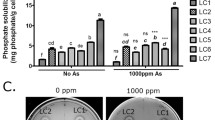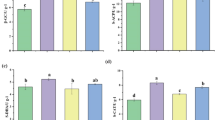Abstract
Arsenic (As) accumulation in agricultural soils is prone to crop uptake, posing risk to human health. Passivation shows potential to inactivate soil labile As and lower crop As uptake but often contributes little to improving the microbiota in As-contaminated soils. Here, the combined addition of ferrihydrite and Trichoderma asperellum SM-12F1 as a potential future application for remediation of As-contaminated soil was studied via pot experiments. The results indicated that, compared with the control treatment, the combined addition of ferrihydrite and T. asperellum SM-12F1 significantly increased water spinach shoot and root biomass by 134 and 138%, respectively, and lowered As content in shoot and root by 37 and 34%, respectively. Soil available As decreased by 40% after the combined addition. The variances in soil pH and As fractionation and speciation were responsible for the changes in soil As availability. Importantly, the combined addition greatly increased the total phospholipid fatty acids (PLFAs) and gram-positive (G+), gram-negative (G−), actinobacterial, bacterial, fungal PLFAs by 114, 68, 276, 292, 133, and 626%, respectively, compared with the control treatment. Correspondingly, the soil enzyme activities closely associated with carbon, nitrogen, and phosphorus mineralization and antioxidant activity were improved. The combination of ferrihydrite and T. asperellum SM-12F1 in soils did not reduce their independent effects.




Similar content being viewed by others
References
Adam N (2016) Phosphate speciation under organic-acid-promoted dissolution of phosphorus-sorbed ferrihydrite-Boehmite mixtures: Implications for soil phosphorus. Soil Sci Soc Am J 80(4):900–910. https://doi.org/10.2136/sssaj2016.02.0024
Allison SD, Jastrow JD (2006) Activities of extracellular enzymes in physically isolated fractions of restored grassland soils. Soil Biol Biochem 38(11):3245–3256. https://doi.org/10.1016/j.soilbio.2006.04.011
Azama HM, Finneranb KT (2013) Ferric iron amendment increases Fe(III)-reducing microbial diversity and carbon oxidation in on-site wastewater systems. Chemosphere 90(4):1435–1443. https://doi.org/10.1016/j.chemosphere.2012.09.002
Azcon R, Medina A, Roldán A, Biró B, Vivas A (2009) Significance of treated agrowaste residue and autochthonous inoculates (Arbuscular mycorrhizal fungi and Bacillus cereus) on bacterial community structure and phytoextraction to remediate soils contaminated with heavy metals. Chemosphere 75(3):327–334. https://doi.org/10.1016/j.chemosphere.2008.12.029
Bhattacharyya P, Tripathy S, Kim K, Kim SH (2008) Arsenic fractions and enzyme activities in arsenic-contaminated soils by groundwater irrigation in West Bengal. Ecotoxicol Environ Saf 71(1):149–156. https://doi.org/10.1016/j.ecoenv.2007.08.015
Cattani I, Beone GM, Gonnelli C (2015) Influence of Rhizophagus irregularis inoculation and phosphorus application on growth and arsenic accumulation in maize (Zea mays L.) cultivated on an arsenic-contaminated soil. Environ Sci Pollut Res 22(9):6570–6577. https://doi.org/10.1007/s11356-014-3837-0
Cutler WG, El-Kadi A, Nguyen VH, Peard J, Scheckel K (2014) Iron amendments to reduce bioaccessible arsenic. J Hazard Mater 279:554–561. https://doi.org/10.1016/j.jhazmat.2014.07.043
DeForest JL (2009) The influence of time, storage temperature, and substrate age on potential soil enzyme activity in acidic forest soils using MUB-linked substrates and L-DOPA. Soil Biol Biochem 41(6):1180–1186. https://doi.org/10.1016/j.soilbio.2009.02.029
Dixit S, Hering JG (2003) Comparison of arsenic (V) and arsenic (III) sorption onto iron oxide minerals: implications for arsenic mobility. Environ Sci Technol 37:4182–4189. https://doi.org/10.1021/es030309t
Dong GW, Huang YH, Yu QQ, Wang YP, Wan HT, He N, Li QB (2014) Role of nanoparticles in controlling arsenic mobilization from sediments near a realgar tailing. Environ Sci Technol 48(13):7469–7476. https://doi.org/10.1021/es4055077
Epelde L, Becerril JM, Barrutia O, Gonzalez-Oreja JA, Garbisu C (2010) Interactions between plant and rhizosphere microbial communities in a metaliferous soil. Environ Pollut 158(5):1576–1583. https://doi.org/10.1016/j.envpol.2009.12.013
Farooq MA, Islam F, Ali B, Najeeb U, Mao BZ, Gill RA, Yan GJ, Siddique KHM, Zhou WJ (2016) Arsenic toxicity in plants: cellular and molecular mechanisms of its transport and metabolism. Environ Exp Bot 132:42–52. https://doi.org/10.1016/j.envexpbot.2016.08.004
Frostegard A, Baath E, Tunlid A (1993) Shifts in the structure of soil microbial communities in limed forests as revealed by phospholipid fatty acid analysis. Soil Biol Biochem 25(6):723–730. https://doi.org/10.1016/0038-0717(93)90113-P
Frostegard A, Tunlid A, Baath A (2011) Use and misuse of PLFA measurements in soils. Soil Biol Biochem 43(8):1621–1625. https://doi.org/10.1016/j.soilbio.2010.11.021
Garau G, Silvetti M, Deiana S, Deiana P, Castaldi P (2011) Long-term influence of red mud on As mobility and soil physico-chemical and microbial parameters in a polluted sub-acidic soil. J Hazard Mater 185(2–3):1241–1248. https://doi.org/10.1016/j.jhazmat.2010.10.037
Guerra DL, Batista AC, Viana RR, Airoldi C (2010) Adsorption of arsenic ions on Brazilian sepiolite: effect of contact time, pH, concentration, and calorimetric investigation. J Colloid Interface Sci 346:178–187. https://doi.org/10.1016/j.jcis.2010.02.041
Hseu ZY, Jien SH, Wang SH, Deng HW (2013) Using EDDS and NTA for enhanced phytoextraction of Cd by water spinach. J Environ Manag 117:58–64. https://doi.org/10.1016/j.jenvman.2012.12.028
Jiang X, Xin X, Li S, Zhou J, Zhu T, Müller C, Cai Z, Wright AL (2015) Effects of Fe oxide on N transformations in subtropical acid soils. Sci Rep 5:1–7. https://doi.org/10.1038/srep08615
Komarek M, Vanek A, Ettler V (2013) Chemical stabilization of metals and arsenic in contaminated soils using oxides—a review. Environ Pollut 172:9–22. https://doi.org/10.1016/j.envpol.2012.07.045
Li SW, Liu X, Sun HJ, Li MY, Zhao D, Luo J, Li HB (2017) Effect of phosphate amendment on relative bioavailability and bioaccessibility of lead and arsenic in contaminated soils. J Hazard Mater 339:256–263. https://doi.org/10.1016/j.jhazmat.2017.06.040
Liang Q, Gao RT, Xi BD, Zhang Y, Zhang H (2014) Long-term effects of irrigation using water from the river receiving treated industrial wastewater on soil organic carbon fractions andenzyme activities. Agric Water Manag 135:100–108. https://doi.org/10.1016/j.agwat.2014.01.003
Liu YC, Zhang ZJ, Li YS, Wen Y, Fei YH (2017) Response of soil microbial communities to roxarsone pollution along a concentration gradient. J Environ Sci Health A Tox Hazard Subst 52(9):819–827. https://doi.org/10.1080/10934529.2017.1281687
Lopes G, Guilerme LRG, Costa ETS, Curi N, Penha HGV (2013) Increasing arsenic sorption on red mud by phosphogypsum addition. J Hazard Mater 262:1196–1203. https://doi.org/10.1016/j.jhazmat.2012.06.051
Ma L, Wang L, Jia YY, Yang ZG (2017) Accumulation, translocation and conversion of six arsenic species in rice plants grown near a mine impacted city. Chemosphere 183:44–52. https://doi.org/10.1016/j.chemosphere.2017.05.089
Mallick I, Bhattacharyya C, Mukherji S, Dey D, Sarkar SC, Ghosh A (2017) Effective rhizoinoculation and biofilm formation by arsenic immobilizing halophilic plant growth promoting bacteria (PGPB) isolated from mangrove rhizosphere: a step towards arsenic rhizoremediation. Sci Total Environ 610-611:1239–1250. https://doi.org/10.1016/j.scitotenv.2017.07.234
Marabottini R, Stazi SR, Papp R, Grego S, Moscatelli MC (2013) Mobility and distribution of arsenic in contaminated mine soils and its effects on the microbial pool. Ecotoxicol Environ Saf 96:147–153. https://doi.org/10.1016/j.ecoenv.2013.06.016
Marques APGC, Moreira H, Franco AR, Range IAOSS, Castro PML (2013) Inoculating Helianthus annuus (sunflower) grown in zinc and cadmium contaminated soils with plant growth promoting bacteria—effects on phytoremediation strategies. Chemosphere 92(1):74–83. https://doi.org/10.1016/j.chemosphere.2013.02.055
Miura T, Makotoa K, Niwa S, Kaneko N, Sakamoto K (2017) Comparison of fatty acid methyl ester methods for characterization of microbial communities in forest and arable soil: phospholipid fraction (PLFA) versus total ester linked fatty acids (EL-FAME). Pedobiologia 63:14–18. https://doi.org/10.1016/j.pedobi.2017.04.002
Niu C, Geng JJ, Ren HQ, Ding LL, Xu K (2012) The cold adaptability of microorganisms with different carbon source in activated sludge treating synthetical wastewater. Bioresour Technol 123:66–71. https://doi.org/10.1016/j.biortech.2012.06.110
Qi WZ, Zhao L (2013) Study of the siderophore-producing Trichoderma asperellum Q1 on cucumber growth promotion under salt stress. J Basic Microbiol 53(4):355–364. https://doi.org/10.1002/jobm.201200031
Sastre J, Hernandez E, Rodrıguez R, Alcobe X, Vidal M, Rauret G (2004) Use of sorption and extraction tests to predict the dynamics of the interaction of trace elements in agricultural soils contaminated by a mine tailing accident. Sci Total Environ 329:261–281. https://doi.org/10.1016/j.scitotenv.2004.03.012
Schwertmann U, Rochelle M (2000) Iron oxides in the laboratory preparation and characterization. Wiley-VCH
Sherman DM, Randall SR (2003) Surface complexation of arsenic(V) to iron(III) (hydr)oxides: structural mechanism from ab initio molecular geometries and EXAFS spectroscopy. Geochim Cosmochim Acta 67(22):4223–4230. https://doi.org/10.1016/S0016-7037(03)00237-0
Su SM, Zeng XB, Li LF, Duan R, Bai LY (2012) Arsenate reduction and methylation in the cells of Trichoderma asperellum SM-12F1, Penicillium janthinellum SM-12F4, and Fusarium oxysporum CZ-8F1 investigated with X-ray absorption near edge structure. J Hazard Mater 243:364–367. https://doi.org/10.1016/j.jhazmat.2012.09.061
Su SM, Zeng XB, Bai LY, Paul N, Wang YY, Wu CX (2017) Inoculating chlamydospores of Trichoderma asperellum SM-12F1 changes arsenic availability and enzyme activity in soils and improves water spinach growth. Chemosphere 175:497–504. https://doi.org/10.1016/j.chemosphere.2017.02.048
Sun YY, Liu RL, Zeng XB, Lin QM, Su SM (2015) Reduction of arsenic bioavailability by amending seven inorganic materials in arsenic contaminated soil. J Integr Agric 14(7):1414–1422. https://doi.org/10.1016/S2095-3119(14)60894-7
Sun WM, Xiao EZ, Xiao TF, Krumins V, Wang Q, Haggblo M, Dong YR, Tang S, Hu M, Li BQ, Xia BQ, Liu W (2017) Response of soil microbial communities to elevated antimony and arsenic contamination indicates the relationship between the innate microbiota and contaminant fractions. Environ Sci Technol 51(16):9165–9175. https://doi.org/10.1021/acs.est.7b00294
Touceda-Gonzalez M, Brader G, Antonielli L, Ravindran VB, Waldner G, Friesl-Han W, Corretto E, Campisano A, Pancher M, Sessitsch A (2015) Combined amendment of immobilizers and the plant growth-promoting strain Burkholderia phytofirmans PsJN favours plant growth and reduces heavy metal uptake. Soil Biol Biochem 91:140–150. https://doi.org/10.1016/j.soilbio.2015.08.038
Tripathi P, Singh PC, Mishra A, Tripathi RD, Nautiyal CS (2015) Trichoderma inoculation augments grain amino acids and mineral nutrients by modulating arsenic speciation and accumulation in chickpea (Cicer arietinum L.). Ecotoxicol Environ Saf 117:72–80. https://doi.org/10.1016/j.ecoenv.2014.10.027
Udeigwe TK, Eze PN, Teboh JM, Stietiya MH (2011) Application, chemistry, and environmental implications of contaminant-immobilization amendments on agricultural soil and water quality. Environ Int 37(1):258–267. https://doi.org/10.1016/j.envint.2010.08.008
Wang XR, Su SM, Zeng XB, Bai LY, Li LF, Duan R, Wang YN, Wu CX (2015) Inoculation with chlamydospores of Trichoderma asperellum SM-12F1 accelerated arsenic volatilization and influenced arsenic availability in soils. J Integr Agric 14(2):389–397. https://doi.org/10.1016/S2095-3119(14)60772-3
Wenzel WW, Kirchbaumer N, Prohaska T, Stingeder G, Lombi E, Adrian DC (2001) Arsenic fractionation in soils using an improved sequential extraction procedure. Anal Chim Acta 436(2):309–323. https://doi.org/10.1016/S0003-2670(01)00924-2
Woolson E, Axley J, Kearney P (1971) Correlation between available soil arsenic, estimated by six methods, and response of corn (Zea mays L.). Soil Sci Soc Am J 35:101–105
Xian Y, Wang ME, Chen WP (2015) Quantitative assessment on soil enzyme activities of heavy metal contaminated soils with various soil properties. Chemosphere 139:604–608. https://doi.org/10.1016/j.chemosphere.2014.12.060
Yamada C, Kato S, Uen Y, Ishii M, Igarashi Y (2014) Inhibitory effects of ferrihydrite on a thermophilic methanogenic community. Microbes Environ 29(2):227–230. https://doi.org/10.1264/jsme2.ME14026
Yao ZY, Wang HZ, Wu LS, Wu JJ, Brookes PC, Xu JM (2014) Interaction between the microbial community and invading Escherichia coli O157:H7 in soils from vegetable fields. Appl Environ Microbiol 80(1):70–76. https://doi.org/10.1128/AEM.03046-13
Zeng XB, Su SM, Jiang XL, Li LF, Bai LY, Zhang YR (2010) Capability of pentavalent arsenic bioaccumulation and biovolatilization of three fungal strains under laboratory conditions. Clean-Soil Air Water 38(3):238–241. https://doi.org/10.1002/clen.200900282
Zhao L, Zhang YQ (2015) Effects of phosphate solubilization and phytohormone production of Trichoderma asperellum Q1 on promoting cucumber growth under salt stress. Agric Sci China 14(8):1588–1597. https://doi.org/10.1016/S2095-3119(14)60966-7
Funding
This study was financially supported by the National Foundation of Natural Science of China, Grant No. 41671328 and the Yong Elite Scientist Sponsorship Program by the China Association for Science and Technology, Grant No.2015QNRC001.
Author information
Authors and Affiliations
Corresponding author
Additional information
Responsible editor: Robert Duran
Core ideas
• Ferrihydrite (FH) and T. asperellum (CH) were applied into soil As remediation
• FH + CH improved water spinach growth and reducing As uptake
• FH + CH addition significantly decreased soil available As content by 40%
• FH + CH addition improved soil microbial diversity and enzyme activities
Electronic supplementary material
ESM 1
(DOCX 192 kb)
Rights and permissions
About this article
Cite this article
Zhang, H., Zeng, X., Bai, L. et al. Reduced arsenic availability and plant uptake and improved soil microbial diversity through combined addition of ferrihydrite and Trichoderma asperellum SM-12F1. Environ Sci Pollut Res 25, 24125–24134 (2018). https://doi.org/10.1007/s11356-018-2451-y
Received:
Accepted:
Published:
Issue Date:
DOI: https://doi.org/10.1007/s11356-018-2451-y




